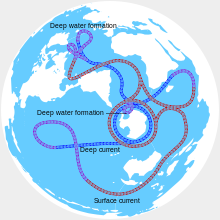User:Siva.tecz/sandbox
- "Natural" and "Natural World" redirect here. For other uses, see Nature (disambiguation) and Natural (disambiguation).
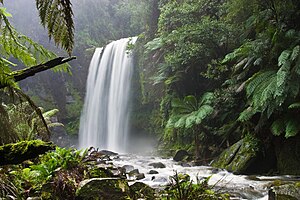

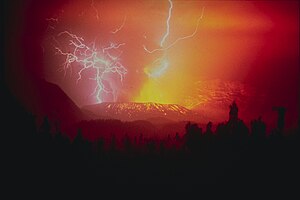
Nature, in the broadest sense, is equivalent to the natural world, physical world, or material world. "Nature" refers to the
The word nature is derived from the Latin word natura, or "essential qualities, innate disposition", and in ancient times, literally meant "birth".[1] Natura was a Latin translation of the Greek word physis (φύσις), which originally related to the intrinsic characteristics that plants, animals, and other features of the world develop of their own accord.[2][3] The concept of nature as a whole, the physical universe, is one of several expansions of the original notion; it began with certain core applications of the word φύσις by pre-Socratic philosophers, and has steadily gained currency ever since. This usage was confirmed during the advent of modern scientific method in the last several centuries.[4][5]
Within the various uses of the word today, "nature" often refers to geology and wildlife. Nature may refer to the general realm of various types of living plants and animals, and in some cases to the processes associated with inanimate objects – the way that particular types of things exist and change of their own accord, such as the weather and geology of the Earth, and the matter and energy of which all these things are composed. It is often taken to mean the "natural environment" or wilderness–wild animals, rocks, forest, beaches, and in general those things that have not been substantially altered by human intervention, or which persist despite human intervention. For example, manufactured objects and human interaction generally are not considered part of nature, unless qualified as, for example, "human nature" or "the whole of nature". This more traditional concept of natural things which can still be found today implies a distinction between the natural and the artificial, with the artificial being understood as that which has been brought into being by a human consciousness or a human mind. Depending on the particular context, the term "natural" might also be distinguished from the unnatural, the supernatural, or synthetic.
Earth

Earth has evolved through geological and biological processes that have left traces of the original conditions. The
The atmospheric conditions have been significantly altered from the original conditions by the presence of life-forms,[7] which create an ecological balance that stabilizes the surface conditions. Despite the wide regional variations in climate by latitude and other geographic factors, the long-term average global climate is quite stable during interglacial periods,[8] and variations of a degree or two of average global temperature have historically had major effects on the ecological balance, and on the actual geography of the Earth.[9][10]
Geology
Geology is the
Geological evolution
The geology of an area evolves through time as rock units are deposited and inserted and deformational processes change their shapes and locations.
Rock units are first emplaced either by
, push upwards into the overlying rock, and crystallize as they intrude.After the initial sequence of rocks has been deposited, the rock units can be
Historical perspective
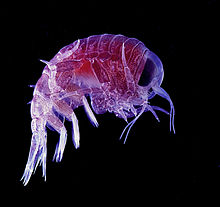

Earth is estimated to have formed 4.54 billion years ago from the
Continents formed, then broke up and reformed as the surface of Earth reshaped over hundreds of millions of years, occasionally combining to make a supercontinent. Roughly 750 million years ago, the earliest known supercontinent Rodinia, began to break apart. The continents later recombined to form Pannotia which broke apart about 540 million years ago, then finally Pangaea, which broke apart about 180 million years ago.[15]
There is significant evidence that a severe glacial action during the Neoproterozoic era covered much of the planet in a sheet of ice. This hypothesis has been termed the "Snowball Earth", and it is of particular interest as it precedes the Cambrian explosion in which multicellular life forms began to proliferate about 530–540 million years ago.[16]
Since the Cambrian explosion there have been five distinctly identifiable mass extinctions.[17] The last mass extinction occurred some 65 million years ago, when a meteorite collision probably triggered the extinction of the non-avian dinosaurs and other large reptiles, but spared small animals such as mammals, which then resembled shrews. Over the past 65 million years, mammalian life diversified.[18]
Several million years ago, a species of small African
period, required about 300 million years to culminate.The present era is classified as part of a mass extinction event, the Holocene extinction event, the fastest ever to have occurred.[19][20] Some, such as E. O. Wilson of Harvard University, predict that human destruction of the biosphere could cause the extinction of one-half of all species in the next 100 years.[21] The extent of the current extinction event is still being researched, debated and calculated by biologists.[22]
Atmosphere, climate, and weather


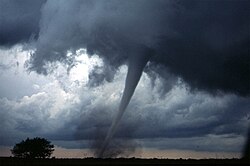
The atmosphere of the Earth serves as a key factor in sustaining the planetary
Terrestrial weather occurs almost exclusively in the
Weather can have both beneficial and harmful effects. Extremes in weather, such as
The planetary climate is a measure of the long-term trends in the weather. Various factors are known to influence the climate, including ocean currents, surface albedo, greenhouse gases, variations in the solar luminosity, and changes to the planet's orbit. Based on historical records, the Earth is known to have undergone drastic climate changes in the past, including ice ages.
The climate of a region depends on a number of factors, especially
Weather is a chaotic system that is readily modified by small changes to the environment, so accurate weather forecasting is currently limited to only a few days.[citation needed] Overall, two things are currently happening worldwide: (1) temperature is increasing on the average; and (2) regional climates have been undergoing noticeable changes.[25]
Water on Earth

Water is a
Oceans
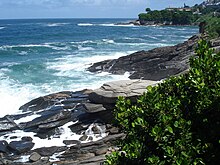
| Earth's ocean |
|---|
|
Main five oceans division: Further subdivision: Marginal seas |
An
The major oceanic divisions are defined in part by the continents, various archipelagos, and other criteria: these divisions are (in descending order of size) the Pacific Ocean, the Atlantic Ocean, the Indian Ocean, the Southern Ocean and the Arctic Ocean. Smaller regions of the oceans are called seas, gulfs, bays and other names. There are also salt lakes, which are smaller bodies of landlocked saltwater that are not interconnected with the World Ocean. Two notable examples of salt lakes are the Aral Sea and the Great Salt Lake.
Lakes
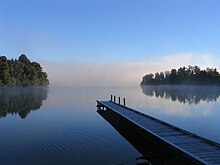
A
Ponds
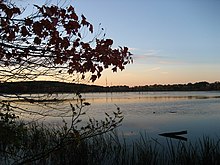
A pond is a
Rivers

A
Streams
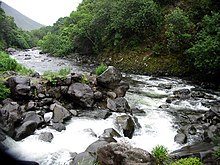
A stream is a flowing body of water with a
Ecosystems


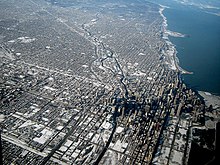
Ecosystems are composed of a variety of
Central to the ecosystem concept is the idea that
A smaller unit of size is called a microecosystem. For example, a microsystem can be a stone and all the life under it. A macroecosystem might involve a whole ecoregion, with its drainage basin.[42]
Wilderness
Wilderness is generally defined as areas that have not been significantly modified by
.Life
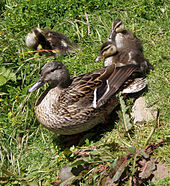
Although there is no universal agreement on the definition of life, scientists generally accept that the biological manifestation of life is characterized by organization, metabolism, growth, adaptation, response to stimuli and reproduction.[44] Life may also be said to be simply the characteristic state of organisms.
Properties common to terrestrial organisms (
The
Over nine-tenths of the total biomass on Earth is plant life, on which animal life depends very heavily for its existence.[46] More than 2 million species of plant and animal life have been identified to date,[47] and estimates of the actual number of existing species range from several million to well over 50 million.[48][49][50] The number of individual species of life is constantly in some degree of flux, with new species appearing and others ceasing to exist on a continual basis.[51][52] The total number of species is presently in rapid decline.[53][54][55]
Evolution
Life is only known to exist on the planet Earth.(cf
Species that were unable to adapt to the changing environment and competition from other life forms became extinct. However, the fossil record retains evidence of many of these older species. Current fossil and DNA evidence shows that all existing species can trace a continual ancestry back to the first primitive life forms.[58]
The advent of
Microbes
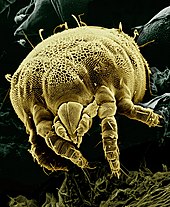
The first form of life to develop on the Earth were microbes, and they remained the only form of life on the planet until about a billion years ago when multi-cellular organisms began to appear.
These life forms are found in almost every location on the Earth where there is liquid water, including the interior of rocks within the planet.[61] Their reproduction is both rapid and profuse. The combination of a high mutation rate and a
Plants, animals and microbes
Originally
Among the many ways of classifying
of plant life from a previous era. People in many regions and countries take great pride in their individual arrays of characteristic flora, which can vary widely across the globe due to differences in climate and terrain
Regional floras commonly are divided into categories such as native flora and agricultural and garden flora, the lastly mentioned of which are intentionally grown and cultivated. Some types of "native flora" actually have been introduced centuries ago by people migrating from one region or continent to another, and become an integral part of the native, or natural flora of the place to which they were introduced. This is an example of how human interaction with nature can blur the boundary of what is considered nature.
Another category of plant has historically been carved out for weeds. Though the term has fallen into disfavor among
With a few exceptions, most notably the
, a framework upon which cells can move about and be reorganized during development and maturation, and which supports the complex anatomy required for mobility.Human interrelationship

Although humans currently comprise only a minuscule proportion of the total living biomass on Earth, the human effect on nature is disproportionately large. Because of the extent of human influence, the boundaries between what humans regard as nature and "made environments" is not clear cut except at the extremes. Even at the extremes, the amount of natural environment that is free of discernible human influence is presently diminishing at an increasingly rapid pace.
The development of technology by the human race has allowed the greater exploitation of natural resources and has helped to alleviate some of the risk from natural hazards. In spite of this progress, however, the fate of human civilization remains closely linked to changes in the environment. There exists a highly complex feedback loop between the use of advanced technology and changes to the environment that are only slowly becoming understood.[66] Man-made threats to the Earth's natural environment include pollution, deforestation, and disasters such as oil spills. Humans have contributed to the extinction of many plants and animals.
Humans employ nature for both leisure and economic activities. The acquisition of natural resources for industrial use remains the primary component of the world's economic system. [
Although early humans gathered uncultivated plant materials for food and employed the medicinal properties of vegetation for healing,[67] most modern human use of plants is through agriculture. The clearance of large tracts of land for crop growth has led to a significant reduction in the amount available of forestation and wetlands, resulting in the loss of habitat for many plant and animal species as well as increased erosion.[68]
Aesthetics and beauty
Although natural wonders are celebrated in the
Matter and energy

Some fields of science see nature as matter in motion, obeying certain laws of nature which science seeks to understand. For this reason the most fundamental science is generally understood to be "physics" – the name for which is still recognizable as meaning that it is the study of nature.
Matter is commonly defined as the substance of which physical objects are composed. It constitutes the observable universe. The visible components of the universe are now believed to compose only 4.9 percent of the total mass. The remainder is believed to consist of 26.8 percent cold dark matter and 68.3 percent dark energy.[72] The exact nature of these components is still unknown and is currently under intensive investigation by physicists.
The behavior of matter and energy throughout the observable universe appears to follow well-defined
Beyond Earth
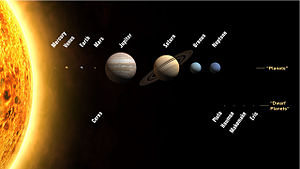
Outer space, also simply called space, refers to the relatively empty regions of the
Outer space is sparsely filled with several dozen types of
Although the planet Earth is currently the only known body within the solar system to support life, current evidence suggests that in the distant past the planet Mars possessed bodies of liquid water on the surface.[75] For a brief period in Mars' history, it may have also been capable of forming life. At present though, most of the water remaining on Mars is frozen. If life exists at all on Mars, it is most likely to be located underground where liquid water can still exist.[76]
Conditions on the other terrestrial planets, Mercury and Venus, appear to be too harsh to support life as we know it. [citation needed] But it has been conjectured that Europa, the fourth-largest moon of Jupiter, may possess a sub-surface ocean of liquid water and could potentially host life.[77]
Nowadays, astronomers started to discover extrasolar Earth analogs – planets that lie in the habitable zone of space surrounding a star, and therefore could possibly host life as we know it.[78]
See also
Media:
- Natural History, by Pliny the Elder
- Nature, by Ralph Waldo Emerson
- Nature, a prominent scientific journal
- National Wildlife (magazine), publication of the National Wildlife Federation
- Nature (TV series)
Organizations:
Science:
Philosophy:
- Mother Nature
- Nature (philosophy)
- Naturalism (philosophy): any of several philosophical stances, typically those descended from Materialism and Pragmatism that do not distinguish the supernatural from nature. [citation needed] This includes the methodological naturalism of natural science, which makes the methodological assumption that observable events in nature are explained only by natural causes, without assuming either the existence or non-existence of the supernatural.
- Balance of nature (biological fallacy): A discredited concept of natural equilibrium in predator:prey dynamics.
Notes and references
- ^ Harper, Douglas. "nature". Online Etymology Dictionary. Retrieved 2006-09-23.
- ^ A useful though somewhat erratically presented account of the pre-Socratic use of the concept of φύσις may be found in Naddaf, Gerard The Greek Concept of Nature, SUNY Press, 2006. The word φύσις, while first used in connection with a plant in Homer, occurs very early in Greek philosophy, and in several senses. Generally, these senses match rather well the current senses in which the English word nature is used, as confirmed by Guthrie, W.K.C. Presocratic Tradition from Parmenides to Democritus (volume 2 of his History of Greek Philosophy), Cambridge UP, 1965.
- ^ The first known use of physis was by Homer in reference to the intrinsic qualities of a plant: ὣς ἄρα φωνήσας πόρε φάρμακον ἀργεϊφόντης ἐκ γαίης ἐρύσας, καί μοι φύσιν αὐτοῦ ἔδειξε. (So saying, Argeiphontes [=Hermes] gave me the herb, drawing it from the ground, and showed me its nature.) Odyssey 10.302-3 (ed. A.T. Murray). (The word is dealt with thoroughly in Liddell and Scott's Greek Lexicon.) For later but still very early Greek uses of the term, see earlier note.
- Philosophiae Naturalis Principia Mathematica (1687), for example, is translated "Mathematical Principles of Natural Philosophy", and reflects the then-current use of the words "natural philosophy", akin to "systematic study of nature"
- ^ The etymology of the word "physical" shows its use as a synonym for "natural" in about the mid-15th century: Harper, Douglas. "physical". Online Etymology Dictionary. Retrieved 2006-09-20.
- ^ "World Climates". Blue Planet Biomes. Retrieved 2006-09-21.
- ^ "Calculations favor reducing atmosphere for early Earth". Science Daily. 2005-09-11. Retrieved 2007-01-06.
- ^ "Past Climate Change". U.S. Environmental Protection Agency. Retrieved 2007-01-07.
- ^ Hugh Anderson, Bernard Walter (March 28, 1997). "History of Climate Change". NASA. Archived from the original on 2008-01-23. Retrieved 2007-01-07.
- ^ Weart, Spencer (June 2006). "The Discovery of Global Warming". American Institute of Physics. Retrieved 2007-01-07.
{{cite web}}: CS1 maint: date and year (link) - ^ )
- ISBN 0-8047-1569-6.
- ^
Morbidelli, A.; Chambers, J.; Lunine, J. I.; Petit, J. M.; Robert, F.; Valsecchi, G. B.; Cyr, K. E. (2000). "Source Regions and Time Scales for the Delivery of Water to Earth". Meteoritics & Planetary Science. 35 (6): 1309–1320. S2CID 129817341.
- ^ "Earth's Oldest Mineral Grains Suggest an Early Start for Life". NASA Astrobiology Institute. 2001-12-24. Retrieved 2006-05-24.
- doi:10.1511/2004.4.324.)
{{cite journal}}: Unknown parameter|coauthors=ignored (|author=suggested) (help - )
- S2CID 43002817.)
{{cite journal}}: CS1 maint: date and year (link - )
- PMID 2574887.
- PMID 11344295.
- S2CID 52953180.
- ^ See, e.g. [1], [2], [3]
- ^ "Ideal Gases under Constant Volume, Constant Pressure, Constant Temperature, & Adiabatic Conditions". NASA. Retrieved 2007-01-07.
- PMID 11875208.
- ^ "Tropical Ocean Warming Drives Recent Northern Hemisphere Climate Change". Science Daily. April 6, 2001. Retrieved 2006-05-24.
- ^ "Water for Life". Un.org. 2005-03-22. Retrieved 2011-05-14.
- ^ "World". CIA - The world fact book. Retrieved 2008-12-20.
- ^ Water Vapor in the Climate System, Special Report, American Geophysical Union, December 1995.
- UNEP.
- ^ "Ocean". The Columbia Encyclopedia. 2002. New York: Columbia University Press
- ^ "Distribution of land and water on the planet". UN Atlas of the Oceans
- ^ Spilhaus, Athelstan F. 1942 (Jul.). "Maps of the whole world ocean." Geographical Review (American Geographical Society). Vol. 32 (3): pp. 431–5.
- ^ Brittanica online. "Lake (physical feature)". Retrieved 2008-06-25.
[a Lake is] any relatively large body of slowly moving or standing water that occupies an inland basin of appreciable size. Definitions that precisely distinguish lakes, ponds, swamps, and even rivers and other bodies of nonoceanic water are not well established. It may be said, however, that rivers and streams are relatively fast moving; marshes and swamps contain relatively large quantities of grasses, trees, or shrubs; and ponds are relatively small in comparison to lakes. Geologically defined, lakes are temporary bodies of water.
- ^ a body of fresh or salt water of considerable size, surrounded by land. "Dictionary.com definition". Retrieved 2008-06-25.
{{cite web}}: Check|url=value (help) - ^ River {definition} from Merriam-Webster. Accessed February 2010.
- ^ River[dead link], Wordnet
- ?
- S2CID 6894397.
- ^ Pidwirny, Michael (2006). "Introduction to the Biosphere: Introduction to the Ecosystem Concept". Fundamentals of Physical Geography (2nd Edition). Retrieved September 28, 2006.
- ^ Odum, EP (1971) Fundamentals of ecology, third edition, Saunders New York
- ^ Pidwirny, Michael (2006). "Introduction to the Biosphere: Organization of Life". Fundamentals of Physical Geography (2nd Edition). Retrieved September 28, 2006.
- S2CID 31998098.)
{{cite journal}}: CS1 maint: date and year (link - ISBN 1559634650.
- ^ "Definition of Life". California Academy of Sciences. 2006. Retrieved 2007-01-07.
- ISBN 0-88936-882-1., which takes global average weight as 60 kg.), the total human biomass is the average weight multiplied by the current human population of approximately 6.5 billion (see, e.g., "World Population Information". U.S. Census Bureau. Retrieved September 28, 2006.): Assuming 60–70 kg to be the average human mass (approximately 130–150 lb on the average), an approximation of total global human mass of between 390 billion (390×109) and 455 billion kg (between 845 billion and 975 billion lb, or about 423 million–488 million short tons). The total biomass of all kinds on earth is estimated to be in excess of 6.8 x 1013 kg (75 billion short tons). By these calculations, the portion of total biomass accounted for by humans would be very roughly 0.6%.
- ^ Sengbusch, Peter V. "The Flow of Energy in Ecosystems – Productivity, Food Chain, and Trophic Level". Botany online. University of Hamburg Department of Biology. Retrieved September 23, 2006.
- ^ Pidwirny, Michael (2006). "Introduction to the Biosphere: Species Diversity and Biodiversity". Fundamentals of Physical Geography (2nd Edition). Retrieved September 23, 2006.
- ^ "How Many Species are There?". Extinction Web Page Class Notes. Retrieved September 23, 2006.
- ^ "Animal." World Book Encyclopedia. 16 vols. Chicago: World Book, 2003. This source gives an estimate of from 2 to 50 million.
- ^ "Just How Many Species Are There, Anyway?". Science Daily. May 2003. Retrieved September 26, 2006.
{{cite web}}: CS1 maint: date and year (link) - ^ Withers, Mark A. (1998). "Changing Patterns in the Number of Species in North American Floras". Land Use History of North America. Retrieved September 26, 2006.
{{cite web}}: Unknown parameter|coauthors=ignored (|author=suggested) (help) Website based on the contents of the book: Sisk, T.D., ed., ed. (1998). Perspectives on the land use history of North America: a context for understanding our changing environment (Revised September 1999 ed.). U.S. Geological Survey, Biological Resources Division. USGS/BRD/BSR-1998-0003.{{cite book}}:|editor=has generic name (help)CS1 maint: multiple names: editors list (link) - ^ "Tropical Scientists Find Fewer Species Than Expected". Science Daily. April 2002. Retrieved September 27, 2006.
{{cite web}}: CS1 maint: date and year (link) - S2CID 42696030.)
{{cite journal}}: CS1 maint: date and year (link - S2CID 23011961.
- ISBN 92-807-2087-2.)
{{cite book}}:|editor=has generic name (help)CS1 maint: multiple names: editors list (link - ^ "Why the Amazon Rainforest is So Rich in Species : News". Earthobservatory.nasa.gov. 2005-12-05. Retrieved 2011-05-14.
- ^ "Why The Amazon Rainforest Is So Rich In Species". Sciencedaily.com. 2005-12-05. Retrieved 2011-05-14.
- ^ PMID 11782495.
- ISSN 1520-0469.)
{{cite journal}}: CS1 maint: date and year (link - PMID 8041691.
- PMID 11607462.)
{{cite journal}}: CS1 maint: multiple names: authors list (link - PMID 14743976.
- PMID 11541716.
- ^ "flora". Merriam-Webster Online Dictionary. Merriam-Webster. Retrieved September 27, 2006.
- ^ "Glossary". Status and Trends of the Nation's Biological Resources. Reston, VA: Department of the Interior, Geological Survey. 1998. SuDocs No. I 19.202:ST 1/V.1-2. Archived from the original on 2007-07-15.
- ^ "Feedback Loops In Global Climate Change Point To A Very Hot 21st Century". Science Daily. May 22, 2006. Retrieved 2007-01-07.
- ^ "Plant Conservation Alliance – Medicinal Plant Working Groups Green Medicine". US National Park Services. Retrieved September 23, 2006.
- ^ Oosthoek, Jan (1999). "Environmental History: Between Science & Philosophy". Environmental History Resources. Retrieved 2006-12-01.
- ^ For an example of a range of opinions, see: "On the Beauty of Nature". The Wilderness Society. Retrieved September 29, 2006. and Ralph Waldo Emerson's analysis of the subject: Emerson, Ralph Waldo (1849). "Beauty". Nature; Addresses and Lectures.
- ^ History of Conservation BC Spaces for Nature. Accessed: May 20, 2006.
- ISBN 978-1608192168.
- )
- ^ Taylor, Barry N. (1971). "Introduction to the constants for nonexperts". National Institute of Standards and Technology. Retrieved 2007-01-07.
- doi:10.1063/1.1302777.)
{{cite journal}}: CS1 maint: multiple names: authors list (link - S2CID 13968348.
- ^ Malik, Tariq (2005-03-08). "Hunt for Mars life should go underground". The Brown University News Bureau. Retrieved September 4, 2006.
- ^ Scott Turner (1998-03-02). "Detailed Images From Europa Point To Slush Below Surface". The Brown University News Bureau. Retrieved September 28, 2006.
- ^ http://www.space.com/11188-alien-earths-planets-sun-stars.html
External links
- The IUCN Red List of Threatened Species (iucnredlist.org)
- The Wild Foundation – The heart of the global wilderness conservation movement (wild.org)*
- Fauna & Flora International is taking decisive action to help save the world’s wild species and spaces (fauna-flora.org)
- European Wildlife is a Pan-European non-profit organization dedicated to nature preservation and environmental protection (eurowildlife.org)
- Nature Journal (nature.com)
- The National Geographic Society (nationalgeographic.com)
- Record of life on Earth (arkive.org)
- BBC – Science and Nature (bbc.co.uk)
- PBS – Science and Nature (pbs.org)
- Science Daily (sciencedaily.com)
- European Commission – Nature and Biodiversity (ec.europa.eu)
- Natural History Museum (.nhm.ac.uk)
- Encyclopedia of Life (eol.org).
- Science.gov – Environment & Environmental Quality.


